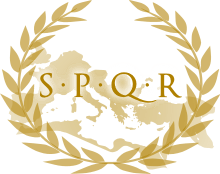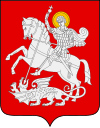Colchis
In pre-Hellenistic Greco-Roman geography, Colchis[a] or Kolchis (Ancient Greek: Κολχίς) was an exonym for the Georgian polity[b] of Egrisi[c] (Georgian: ეგრისი) located on the coast of the Black Sea, centered in present-day western Georgia.
Colchis ეგრისი Egrisi | |||||||||
|---|---|---|---|---|---|---|---|---|---|
| 13th century BC – 164 BC | |||||||||
-en.svg.png) Colchis and Iberia | |||||||||
| Capital | Aea | ||||||||
| Common languages | Kartvelian languages | ||||||||
| Religion | Polytheism | ||||||||
| Historical era | Iron Age | ||||||||
• Established | 13th century BC | ||||||||
• Conquest of Diauehi | 750 BC | ||||||||
• Disestablished | 164 BC | ||||||||
| |||||||||
| Today part of | |||||||||
| History of Georgia |
|---|
 |
|
Middle Ages
|
|
Early modern history |
|
Modern history |
|
History by topic |
|
|
It has been described in modern scholarship as "the earliest Georgian formation" which, along with the Kingdom of Iberia, would later contribute significantly to the development of the medieval Georgian statehood and the Georgian nation.[1][2]
Colchis is known in Greek mythology as the destination of the Argonauts, as well as the home to Medea and the Golden Fleece.[3] It was also described as a land rich with gold, iron, timber and honey that would export its resources mostly to ancient Hellenic city-states.[4]
Colchis was populated by Colchians, an early Kartvelian-speaking tribe, ancestral to the contemporary western Georgians, namely Svans and Zans.[5][6] Its geography is mostly assigned to what is now the western part of Georgia and encompasses the present-day Georgian provinces of Samegrelo, Imereti, Guria, Adjara, Abkhazeti, Svaneti, Racha; modern Russia's Sochi and Tuapse districts; and present-day Turkey’s Artvin, Rize, and Trabzon provinces.[7]
Geography and toponyms
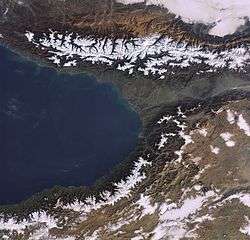
Colchís, Kolkhís[8][9][10][11] or Qulḫa[12][13][14] which existed from the c. 13th to the 1st centuries BC, is regarded as an early ethnically Georgian polity; the name of the Colchians was used as the collective term for early Kartvelian tribes which populated the eastern coast of the Black Sea in Greco-Roman ethnography.[15]
The name Colchis is thought to have derived from the Urartian Qulḫa, pronounced as "Kolkha".[16] In the late eighth century BC, Sarduri II the King of Urartu, inscribed his victory over Qulḫa on a stele; however, the exact location of Qulḫa is disputed. Some scholars argue the name Qulḫa (Colchís) originally referred to a land to the west of Georgia.[17][18]
According to the scholar of Caucasian studies Cyril Toumanoff:
Colchis appears as the first Caucasian State to have achieved the coalescence of the newcomer. Colchis can be justly regarded as not a proto-Georgian, but a Georgian (West Georgian) kingdom. . . .It would seem natural to seek the beginnings of Georgian social history in Colchis, the earliest Georgian formation.[1]
A second South Caucasian tribal union emerged in the thirteenth century BC on the Black Sea coast.[19][20] According to most classic authors, a district which was bounded on the south-west by Pontus, on the west by the Black Sea as far as the river Corax (probably the present day Bzyb River, Abkhazia, Georgia), on the north by the chain of the Greater Caucasus, which lay between it and Asiatic Sarmatia, on the east by Iberia and Montes Moschici (now the Lesser Caucasus), and on the south by Armenia. The westward extent of the country is considered differently by different authors: Strabo makes Colchis begin at Trabzon, while Ptolemy, on the other hand, extends Pontus to the Rioni River.
The Greek name Kolchís (Κολχίς) is first used to describe a geographic area in the writings of Aeschylus and Pindar. Earlier writers speak of the "Kolchian" (Κολχίδα) people and their mythical king Aeëtes (Αἰήτης), as well as his eponymous city Aea or Aia (Αἶα),[21][22][23] but don't make explicit references to a Kolchis nation or region. The main river was known as the Phasis (now Rioni) and was, according to some writers the southern boundary of Colchis, but more probably flowed through the middle of that country from the Caucasus west into the Euxine, and the Anticites or Atticitus (now Kuban). Arrian mentions many others by name, but they would seem to have been little more than mountain torrents: the most important of them were Charieis, Chobus or Cobus, Singames, Tarsuras, Hippus, Astelephus, Chrysorrhoas, several of which are also noticed by Ptolemy and Pliny. The chief towns were Dioscurias or Dioscuris (under the Romans called Sebastopolis, now Sukhumi) on the seaboard of the Euxine, Sarapana (now Shorapani), Phasis (now Poti), Pityus (now Pitsunda), Apsaros (now Gonio), Surium (now Vani), Archaeopolis (now Nokalakevi), Macheiresis, and Cyta or Cutatisium or Aia (now Kutaisi), the traditional birthplace of Medea. Scylax mentions also Mala or Male, which he, in contradiction to other writers, makes the birthplace of Medea.
Physical-geographic characteristics
-en.svg.png)
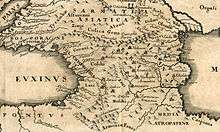
In physical geography, Colchis is usually defined as the area east of the Black Sea coast, restricted from the north by the southwestern slopes of the Greater Caucasus, from the south by the northern slopes of the Lesser Caucasus in Georgia and Eastern Black Sea (Karadeniz) Mountains in Turkey, and from the east by Likhi Range, connecting the Greater and the Lesser Caucasus. The central part of the region is Colchis Plain, stretching between Sukhumi and Kobuleti; most of that lies on the elevation below 20 m above sea level. Marginal parts of the region are mountains of the Great and the Lesser Caucasus and Likhi Range.
Its territory mostly corresponds to what is now the western part of Georgia and encompasses the present-day Georgian provinces of Samegrelo, Imereti, Guria, Adjara, Abkhazia, Svaneti, Racha; the modern Turkey’s Rize, Trabzon and Artvin provinces (Lazistan, Tao-Klarjeti); and the modern Russia’s Sochi and Tuapse districts.[7]
The climate is mild humid; near Batumi, annual rainfall level reaches 4,000 mm, which is the absolute maximum for the continental western Eurasia. The dominating natural landscapes of Colchis are temperate rainforests, yet degraded in the plain part of the region; wetlands (along the coastal parts of Colchis Plain); subalpine and alpine meadows.
Colchis has a high proportion of Neogene and Palaeogene relict plants and animals, with the closest relatives in distant parts of the world: five species of Rhododendrons and other evergreen shrubs, wingnuts, Caucasian salamander, Caucasian parsley frog, eight endemic species of lizards from the genus Darevskia, the Caucasus adder (Vipera kaznakovi), Robert's snow vole, and endemic cave shrimp.[24]
History
Prehistory and earliest references
The eastern Black Sea region in antiquity was home to the well-developed Bronze Age culture known as the Colchian culture, related to the neighbouring Koban culture, that emerged toward the Middle Bronze Age. In at least some parts of Colchis, the process of urbanization seems to have been well advanced by the end of the second millennium BC. The Colchian Late Bronze Age (fifteenth to eighth century BC) saw the development of significant skill in the smelting and casting of metals. Sophisticated farming implements were made, and fertile, well-watered lowlands and a mild climate promoted the growth of progressive agricultural techniques.
Colchis was inhabited by a number of related, but distinct, tribes whose settlements lay along the shore of the Black Sea. Chief among those were the Machelones, Heniochi, Zydretae, Lazi, Chalybes, Tabal/Tibareni/Tubal, Mossynoeci, Macrones, Moschi, Marres, Apsilae, Abasci,[25] Sanigae, Coraxi, Coli, Melanchlaeni, Geloni and Soani (Suani). These Colchian tribes differed so completely in language from the surrounding Indo-European nations that the ancients provided various wild theories to account for the phenomenon.
Herodotus regarded the Colchians as an Ancient Egyptian race.[26] Herodotus states that the Colchians, with the Ancient Egyptians and the Ethiopians, were the first to practice circumcision, a custom which he claims that the Colchians inherited from remnants of the army of Pharaoh Sesostris (Senusret III). Herodotus writes, "For it is plain to see that the Colchians are Egyptians; and what I say, I myself noted before I heard it from others. When it occurred to me, I inquired of both peoples; and the Colchians remembered the Egyptians better than the Egyptians remembered the Colchians; [2] the Egyptians said that they considered the Colchians part of Sesostris' army. I myself guessed it, partly because they are dark-skinned and woolly-haired; though that indeed counts for nothing, since other peoples are, too; but my better proof was that the Colchians and Egyptians and Ethiopians are the only nations that have from the first practised circumcision." These claims have been widely rejected by modern historians. It is in doubt if Herodotus had ever been to Colchis or Egypt.[27][28]
According to Pliny the Elder:
The Colchians were governed by their own kings in the earliest ages, that Sesostris king of Egypt was overcome in Scythia,[29] and put to fight, by the king of Colchis, which if true, that the Colchians not only had kings in those times, but were a very powerful people.[30][31]
Many modern theories suggest that the ancestors of the Laz-Mingrelians constituted the dominant ethnic and cultural presence in the region in antiquity, and hence played a significant role in the ethnogenesis of the modern Georgians.[32][33]
Persian rule
In the thirteenth century BC, the Kingdom of Colchis was formed as a result of the increasing consolidation of the tribes inhabiting the region. This power, celebrated in Greek mythology as the destination of the Argonauts, the home of Medea and the special domain of sorcery, was known to Urartians as Qulha (aka Kolkha, or Kilkhi).
Being in permanent wars with the neighbouring nations, the Colchians managed to absorb part of Diauehi in the 750s BC, but lost several provinces (including the "royal city" of Ildemusa) to the Sarduri II of Urartu following the wars of 750–748 and 744–742 BC. Overrun by the Cimmerians and Scythians in the 730s–720s BC, and invaded by Assyria, the kingdom disintegrated and eventually came under the Achaemenid Persian Empire toward the mid-sixth century BC.
The tribes living in the southern Colchis (Macrones, Moschi, and Marres) were incorporated into the nineteenth Satrapy of Persia, while the northern tribes submitted "voluntarily" and had to send to the Persian court 100 girls and 100 boys every five years. In 400 BC, shortly after the Ten Thousand reached Trapezus, a battle was fought between them and the Colchis in which the latter were decisively defeated. The influence exerted on Colchis by the vast Achaemenid Empire with its thriving commerce and wide economic and commercial ties with other regions accelerated the socio-economic development of the Colchian land. Subsequently, the Colchis people appear to have overthrown the Persian Authority, and to have formed an independent state. According to Ronald Suny: This western Georgian state was federated to Kartli-Iberia, and its kings ruled through skeptukhi (royal governors) who received a staff from the king.[34]
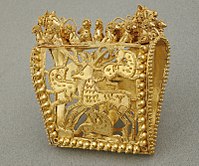 Gold ornaments made by Colchians of the sixth century BC
Gold ornaments made by Colchians of the sixth century BC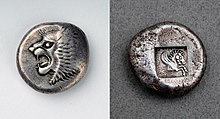 Six century BC Colchian coins
Six century BC Colchian coins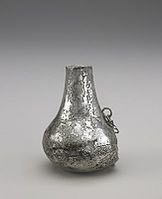 Colchian scent bottle fourth century BC
Colchian scent bottle fourth century BC- Second century BC Greek bronze torso from Colchis, Georgian National Museum
- Colchian pendants, riders and horses on wheeled platforms, Georgian National Museum
Under Pontus
Mithridates VI quelled an uprising in the region in 83 BC and gave Colchis to his son Mithridates, who, soon being suspected in having plotted against his father, was executed. During the Third Mithridatic War, Mithridates VI made another of his sons, Machares, king of Bosporus and Colchis, who held his power, but only for a short period. On the defeat of Mithridates VI of Pontus in 65 BC, Colchis was occupied by Pompey,[35] who captured one of the local chiefs (sceptuchus) Olthaces, and installed Aristarchus as a dynast (63–47 BC). On the fall of Pompey, Pharnaces II, son of Mithridates, took advantage of Julius Caesar being occupied in Egypt, and reduced Colchis, Armenia, and some part of Cappadocia, defeating Gnaeus Domitius Calvinus, whom Caesar subsequently sent against him. His triumph was, however, short-lived. Under Polemon I, the son and heir of Zenon, Colchis was part of the Pontus and the Bosporan Kingdom. After the death of Polemon (8 BC), his second wife Pythodorida of Pontus retained possession of Colchis as well as of Pontus, although the kingdom of Bosporus was wrested from her power. Her son and successor, Polemon II of Pontus, was induced by Emperor Nero to abdicate the throne, and both Pontus and Colchis were incorporated in the Province of Galatia (63) and later, in Cappadocia (81). Phasis, Dioscurias and other Greek settlements of the coast did not fully recover after the wars of 60-40 BC and Trebizond became the economical and political centre of the region.[36]
Under Roman rule
Despite the fact that all major fortresses along the sea coast were occupied by the Romans, their rule was relatively loose. In 69, the people of Pontus and Colchis under Anicetus staged a major uprising against the Romans which ended unsuccessfully.
The lowlands and coastal area were frequently raided by fierce mountain tribes, with the Soanes and Heniochi being the most powerful of them. Paying a nominal homage to Rome, they created their own kingdoms and enjoyed significant independence.
Christianity began to spread in the early first century. Traditional accounts relate the event with Saint Andrew, Saint Simon the Zealot, and Saint Matata. The Hellenistic, local pagan and Mithraic religious beliefs would, however, remain widespread until the fourth century. By the 130s, the kingdoms of Machelones, Heniochi, Egrisi, Apsilia, Abasgia, and Sanigia had occupied the district from south to north. Goths, dwelling in the Crimea and looking for new homes, raided Colchis in 253, but were repulsed with the help of the Roman garrison of Pitsunda. By the first century BC, the Lazica (or the Laz) kingdom was established in the wake of the disintegration of the Kingdom of Colchis. Lazica became known as Elgrisi in 66 BC when Elgrisi became a vassal of the Roman Empire after Pompey's conquest.[37]
Rulers
Little is known of the rulers of Colchis;
| Ruler | Reign | Notes |
|---|---|---|
| 1. Akes (Basileus Aku) | end of the 4th c. BC | his name is found on a coin issued by him. |
| 2. Kuji | 325–280 BC | |
| 3. Saulaces | 2nd c. BC | |
| 4. Mithridates | fl. 80 BC | under the authority of Pontus. |
| 5. Machares | fl. 65 BC | under the authority of Pontus. |
| 6. Aristarchus | 63–47 BC | appointed by Pompey |
In mythology
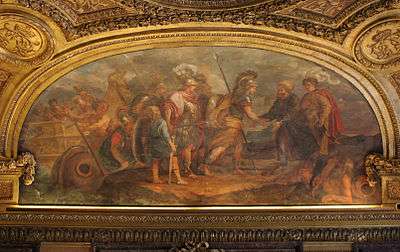
In Classical Greek mythology, Colchis was the home of Aeëtes, Medea, the Golden Fleece, fire-breathing bulls Khalkotauroi[38][39] and the destination of the Argonauts.[40][41]
Colchis also is thought to be a possible homeland of the Amazons.[42][43][44][45][46][47] Amazons also were said to be of Scythian origin from Colchis.[48]
According to the Greek mythology, Colchis was a fabulously wealthy land situated on the mysterious periphery of the heroic world. Here in the sacred grove of the war god Ares, King Aeëtes hung the Golden Fleece until it was seized by Jason and the Argonauts. Colchis was also the land where the mythological Prometheus was punished by being chained to a mountain while an eagle ate at his liver for revealing to humanity the secret of fire.
Apollonius of Rhodes named Aea as the main city (Argonautica, passim). The main mythical characters from Colchis are:
- Absyrtus, son of Aeëtes
- Aeëtes, King of Colchis, son of the sun-god Helios and the Oceanid Perseis, (a daughter of Oceanus), brother of Circe and Pasiphae, and father of Medea, Chalciope, and Absyrtus
- Chalciope, daughter of King Aeëtes
- Circe, sister of King Aeëtes
- Idyia, Queen of Colchis, mother of Medea, Chalciope, and Absyrtus
- Medea, daughter of King Aeëtes
- Pasiphaë, sister of Aeëtes
See also
- Pontus
- Roman Georgia
Explanatory notes
- ^
- ^ Colchis was not an established and structurally institutionalized monarchy.
- ^ Also known as Egri, Egr, Eguri and Egros in The Georgian Chronicles and Conversion of Kartli chronicles. Old Armenian chronicles referred to it as Yeger.
Citations
- Cyril Toumanoff, Studies in Christian Caucasian History, pp. 69, 84
- David Braund, Georgia in Antiquity: A History of Colchis and Transcaucasian Iberia, 550 BC–AD 562, Oxford University Press, USA (September 8, 1994)
- W. E. D. Allen, A history of the Georgian people (1932), p. 123
- Nigel Wilson, Encyclopedia of Ancient Greece, p. 149
- Antiquity 1994. p. 359. The Great Soviet Encyclopedia:Значение слова "Колхи" в Большой Советской Энциклопедии
- The Cambridge Ancient History, John Anthony Crook, Elizabeth Rawson, p. 255
- Andrew Andersen, History of Ancient Caucasus, p. 91
- Castles of God: Fortified Religious Buildings of the World, Peter Harrison p196
- Greek Tragedy, Nancy Sorkin Rabinowitz p151
- Dark of the Moon, Tracy Barrett p190
- Ancient Epic, Katherine Callen King The Argonautica before Appolonius
- The Pre-history of the Armenian People, Igor Mikhailovich Diakonov, p75
- Encyclopædia Britannica, Volume 1, p1040
- Archaeology at the north-east Anatolian frontier, Claudia Sagona, p35
- Georgia in Antiquity: A History of Colchis and Transcaucasian Iberia, 550 BC-AD 562, David Braund Oxford: Clarendon Press, 1994. Pp. 359
- O, Lordkipanidze. (1991). Archeology in Georgia, Weinheim, 110.
- M. Salvini, Geschichte und Kultur der Urartäer (Darmstadt, 1995) 70f.
- Bremmer, J. N. (2007). "The Myth of the Golden Fleece". Journal Ancient Near Eastern Religions, 6, 9–38.
- D. Braund, Georgia in Antiquity: A History of Colchis and Transcaucasian Iberia 550 BC–562 AD, Oxford University Press, 1996.
- James Stuart Olson, An Ethnohistorical Dictionary of the Russian and Soviet Empires, p. 242
- "Herodotus, The Histories, book 1, chapter 2, section 2". www.perseus.tufts.edu. Retrieved 2020-04-07.
They sailed in a long ship to Aea, a city of the Colchians, and to the river Phasis...
- Apollonius of Rhodes (2006). Apollonius Rhodius : the Argonautica. Harvard University Press. pp. II.417. ISBN 0-674-99001-3. OCLC 249603642.
Kolchian Aia lies at the furthest limits of sea and earth,
- "Henry George Liddell, Robert Scott, A Greek-English Lexicon, Α α, , αἶα , αἶα". www.perseus.tufts.edu. Retrieved 2020-04-07.
- Denk, Thomas; Frotzler, Norbert; Davitashvili, Nino (2001-02-01). "Vegetational patterns and distribution of relict taxa in humid temperate forests and wetlands of Georgia (Transcaucasia)". Biological Journal of the Linnean Society. 72 (2): 287–332. doi:10.1111/j.1095-8312.2001.tb01318.x. ISSN 0024-4066.
- According to some scholars, ancient tribes such as the Absilae (mentioned by Pliny, 1st century CE) and Abasgoi (mentioned by Arrian, 2nd century CE) correspond to the modern Abkhazians (Chirikba, V., "On the etymology of the ethnonym 'apswa' "Abkhaz", in The Annual of the Society for the Study of Caucasia, 3, 13-18, Chicago, 1991; Hewitt, B. G., "The valid and non-valid application of philology to history", in Revue des Etudes Georgiennes et Caucasiennes, 6-7, 1990-1991, 247-263; Grand Dictionnaire Encyclopédique Larousse, tome 1, 1985, p. 20). However, this claim is controversial and no academic consensus has yet been reached. Other scholars suggest that these ethnonyms instead reflect a common regional origin, rather than emphasizing a distinct and separate ethnic and cultural identity in antiquity. For example, Tariel Putkaradze, a Georgian scholar, suggests, "In the 3rd-2nd millennia BC the Kartvelian, Abhaz-Abaza, Circassian-Adyghe and Vaynakh tribes must have been part of a great Ibero-Caucasian ethnos. Therefore, it is natural that several tribes or ethnoses descending from them have the names derived from a single stem. The Colchian Aphaz, Apsil, Apšil and north Caucasian Apsua, Abazaha, Abaza, existing in the 1st millennium, were the names denoting different tribes of a common origin. Some of these tribes (Apsils, Apshils) disappeared, others mingled with kindred tribes, and still others have survived to the present day." (Putkaradze, T. The Kartvelians, 2005, translated by Irene Kutsia)
- http://www.perseus.tufts.edu/hopper/text?doc=Hdt.+2.104&fromdoc=Perseus%3Atext%3A1999.01.0126
- Fehling (1994), p. 13
- Marincola (2001), p. 34
- The Shrines and Sepulchres of the Old and New World: Records of Pilgrimages in Many Lands, and Researches Connected with the History of Places Remarkable for Memorials of the Dea, Or Monuments of a Sacred Character; Including Notices of the Funeral Customs of the Principal Nations, Ancient and Modern, Volume 1, Richard Robert Madden, Newby, 1851, p293
- An Universal history, from the earliest account of time, Volume 10, George Sale, George Psalmanazar, Archibald Bower, George Shelvocke, John Campbell, John Swinton, p136 B.II.
- Plin, I, xxxiii, c. 3.
- Miniature Empires: A Historical Dictionary of the Newly Independent States, James Minahan, p. 116
- Cyril Toumanoff, Studies in Christian Caucasian History, p 80
- The Making of the Georgian Nation, 2nd Ed., Ronald Grigor Suny, p 13
- Pompey, Nic Fields p29
- Rayfield, Donald (2013). Edge of Empires: A History of Georgia. ReaktionBooks. p. 28. ISBN 9781780230702.
- West, Barbara A (2009). Encyclopedia of the Peoples of Asia and Oceania. New York: Facts on File. pp. 461. ISBN 978-0-8160-7109-8.
- The Origin of Pagan Idolatry, George Stanley Faber p409
- The Facts on File Companion to Classical Drama, John E. Thorburn Colchian Bulls p145
- The Routledge Handbook of the Peoples and Places of Ancient Western Asia: The Near East from the Early Bronze Age to the Fall of the Persian Empire, Trevor Bryce p171
- World Mythology: An Anthology of Great Myths and Epics, Donna Rosenberg p218
- Celebrate the Divine Feminine: Reclaim Your Power with Ancient Goddess Wisdom: Joy Reichard p169
- John Canzanella: Innocence and Anarchy p58
- Margaret Meserve: Empires of Islam in Renaissance Historical Thought p250
- Diane P. Thompson: The Trojan War: Literature and Legends from the Bronze Age to the Present p193
- Andrew Brown: A New Companion to Greek Tragedy p66
- Mark Amaru Pinkham: The Return of the Serpents of Wisdom The Amazons, The Female Serpents
- William G. Thalmann: Apollonius of Rhodes and the Spaces of Hellenism Apollonius of Rhodes, p.130
General sources
- Braund, David. 1994. Georgia in Antiquity: A History of Colchis and Transcaucasian Iberia 550 BC–AD 562. Clarendon Press, Oxford. ISBN 0-19-814473-3
- Thordarson, Fridrik (1993). "COLCHIS". Encyclopaedia Iranica, Vol. VI, Fasc. 1. pp. 41–42.CS1 maint: ref=harv (link)
- Gocha R. Tsetskhladze. Pichvnari and Its Environs, 6th c BC–4th c AD. Annales Littéraires de l'Université de Franche-Comté, 659, Editeurs: M. Clavel-Lévêque, E. Geny, P. Lévêque. Paris: Presses Universitaires Franc-Comtoises, 1999. ISBN 2-913322-42-5
- Otar Lordkipanidze. Phasis: The River and City of Colchis. Geographica Historica 15, Franz Steiner 2000. ISBN 3-515-07271-3
- Melamid, Alexander (January 1993). "Colchis Today". The Geographical Review. 83 (1): 79–83. doi:10.2307/215382. JSTOR 215382.
- Akaki Urushadze. The Country of the Enchantress Media, Tbilisi, 1984 (in Russian and English)
External links
| Look up Colchis in Wiktionary, the free dictionary. |
| Wikimedia Commons has media related to Colchis. |
- "Colchis" in the Dictionary of Greek and Roman Geography (1854) (ed. William Smith, LLD)
- Colchian coins
- Strabo on Colchis
- Herodotus on Colchis
- Pliny on Colchis
- Golden graves, archeological evidences
- Colchis (in German)
- Colchis at the Piano (amarcord.be) (in Dutch)

